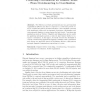Free Online Productivity Tools
i2Speak
i2Symbol
i2OCR
iTex2Img
iWeb2Print
iWeb2Shot
i2Type
iPdf2Split
iPdf2Merge
i2Bopomofo
i2Arabic
i2Style
i2Image
i2PDF
iLatex2Rtf
Sci2ools
SBP
2011
Springer
2011
Springer
Promoting Coordination for Disaster Relief - From Crowdsourcing to Coordination
The efficiency at which governments and non-governmental organizations (NGOs) are able to respond to a crisis and provide relief to victims has gained increased attention. This emphasis coincides with significant events such as tsunamis, hurricanes, earthquakes, and environmental disasters occuring during the last decade. Crowdsourcing applications such as Twitter, Ushahidi, and Sahana have proven useful for gathering information about a crisis yet have limited utility for response coordination. In this paper, we briefly describe the shortfalls of current crowdsourcing applications applied to disaster relief coordination and discuss one approach aimed at facilitating efficient collaborations amongst disparate organizations responding to a crisis.
| Added | 15 May 2011 |
| Updated | 15 May 2011 |
| Type | Journal |
| Year | 2011 |
| Where | SBP |
| Authors | Huiji Gao, Xufei Wang, Geoffrey Barbier, Huan Liu |
Comments (0)

